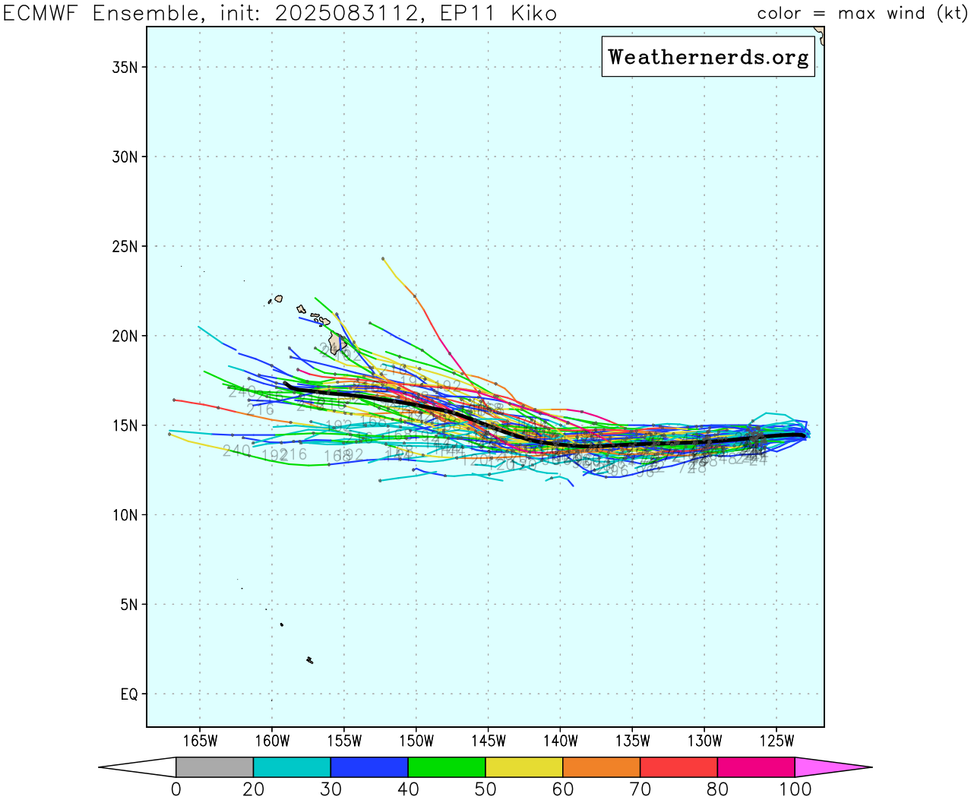They went with 50kt.
BULLETIN
Tropical Storm Kiko Advisory Number 6
NWS National Hurricane Center Miami FL EP112025
500 AM HST Mon Sep 01 2025
...KIKO FORECAST TO RAPIDLY STRENGTHEN INTO A HURRICANE BY
TUESDAY...
SUMMARY OF 500 AM HST...1500 UTC...INFORMATION
----------------------------------------------
LOCATION...14.0N 126.3W
ABOUT 1235 MI...1990 KM WSW OF THE SOUTHERN TIP OF BAJA CALIFORNIA
MAXIMUM SUSTAINED WINDS...60 MPH...95 KM/H
PRESENT MOVEMENT...W OR 265 DEGREES AT 8 MPH...13 KM/H
MINIMUM CENTRAL PRESSURE...998 MB...29.47 INCHES
Tropical Storm Kiko Discussion Number 6
NWS National Hurricane Center Miami FL EP112025
500 AM HST Mon Sep 01 2025
Kiko has intensified overnight and remains a compact storm. A timely
GMI microwave pass revealed a closed cyan ring around the center in
the 37-GHz image. The system’s compact size and improving core
structure suggest that the inner core is consolidating, which often
precedes rapid intensification. Subjective Dvorak intensity
estimates from TAFB are 3.0/45 kt and from SAB are 4.0/64 kt, while
objective estimates have increased into the 40–50 kt range. Given
this range of data and the improving satellite presentation, the
initial intensity is set at 50 kt for this advisory.
Kiko is moving just south of due west, or 265/7 kt, steered by a
mid-level subtropical ridge to the north. This general motion is
expected to continue for the next 36 hours, followed by a more
westward track through about 72 hours. Thereafter, the cyclone
should gradually begin to turn toward the west-northwest as it
crosses into the central Pacific basin between days 4 and 5 due to a
potential weakness in the subtropical ridge far north of the
Hawaiian Islands. While the overall synoptic pattern is consistent,
there remains considerable spread in along-track speed among the
models. The NHC forecast is nearly identical to the previous one and
continues to lean heavily on a blend of the HCCA and EMXI aids,
which are near the faster side of the guidance envelope.
Despite somewhat drier mid-level conditions along its forecast
track, the combination of light vertical wind shear, warm sea
surface temperatures, and Kiko’s small compact core should allow for
strengthening in the short term. Rapid intensification probabilities
from the SHIPS guidance have increased over the past 24 hours, with
around a 30–40 percent chance of a 30-kt increase in the next 24
hours. As a result, the official forecast reflects the potential for
this during the first 24 hours, placing the intensity near the upper
end of the guidance envelope during that period. Kiko’s intensity is
forecast to peak near 85 kt in about 48 hours and then hold steady
through day 5, which is near the middle to upper end of the guidance
envelope.
FORECAST POSITIONS AND MAX WINDS
INIT 01/1500Z 14.0N 126.3W 50 KT 60 MPH
12H 02/0000Z 13.8N 127.4W 60 KT 70 MPH
24H 02/1200Z 13.6N 128.8W 75 KT 85 MPH
36H 03/0000Z 13.5N 130.1W 80 KT 90 MPH
48H 03/1200Z 13.5N 131.7W 85 KT 100 MPH
60H 04/0000Z 13.6N 133.3W 85 KT 100 MPH
72H 04/1200Z 13.7N 135.0W 85 KT 100 MPH
96H 05/1200Z 14.0N 138.3W 85 KT 100 MPH
120H 06/1200Z 14.8N 141.7W 85 KT 100 MPH
$$
Forecaster Gibbs (CPHC)
Visit the Caribbean-Central America Weather Thread where you can find at first post web cams,radars
and observations from Caribbean basin members
Click Here















